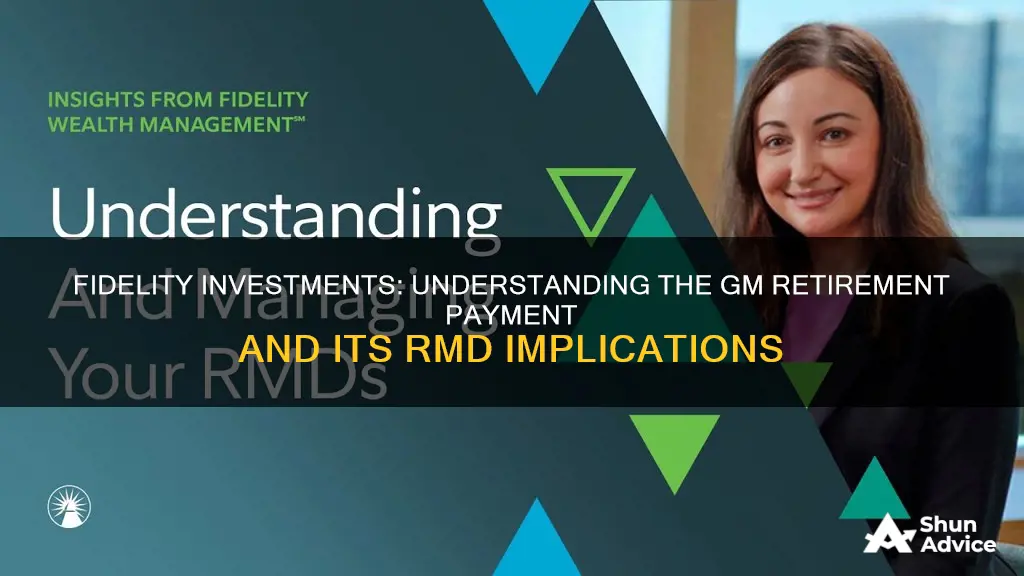
General Motors (GM) offers retirement benefits to its employees, and these benefits are managed by Fidelity Investments. These benefits are subject to certain rules and regulations, including those related to Required Minimum Distributions (RMDs). RMDs are mandatory annual withdrawals from tax-deferred retirement accounts, such as IRAs, 401(k)s, and 403(b)s, that individuals must start taking once they reach a certain age. The age requirement for RMDs has recently changed, and it is important for individuals to understand how this may impact their retirement plans.
| Characteristics | Values |
|---|---|
| RMD Definition | A required minimum distribution (RMD) is a yearly mandatory withdrawal from tax-deferred retirement accounts. |
| RMD Age Requirement | 73 years old. |
| RMD Deadline | December 31 each year. The first RMD can be delayed until April 1 of the following year. |
| RMD Penalty | 25% of the amount not taken on time. |
| RMD Calculation | Determined by dividing the account's year-end balance from the prior year by the account owner's life expectancy factor from the IRS Uniform Lifetime Table. |
| RMD Aggregation | RMDs can be aggregated and withdrawn from a single IRA or 403(b) account. However, RMDs must be withdrawn separately from each 401(k) account. |
| RMD and Work | If still working and not owning more than 5% of the company, individuals may not have to take RMDs from their workplace retirement plan until they retire. |
| RMD and Taxes | RMDs are taxed as ordinary income and are subject to federal and state taxes. |
| RMD and Charity | RMDs can be used for qualified charitable distributions (QCDs) to eligible charities, which can reduce taxable income. |
| RMD Reinvestment | RMD money can be reinvested in a taxable non-retirement account. |
What You'll Learn

What is a required minimum distribution (RMD)?
A required minimum distribution (RMD) is the minimum amount of money that must be withdrawn annually from certain retirement accounts, such as 401(k)s, IRAs, and 403(b)s. The deadline for taking an RMD is December 31 each year, but individuals can delay their first RMD until April 1 of the year after turning 73. RMDs are calculated by dividing the account's year-end balance from the prior year by the account owner's life expectancy, as per the IRS Uniform Lifetime Table.
RMDs are mandatory, and failure to withdraw the correct amount by the deadline can result in a penalty from the IRS. The penalty for not taking an RMD, or for withdrawing less than the required amount, is significant: 25% of the amount not taken on time. This penalty may be reduced if the taxpayer takes the missed distributions within a specific timeframe.
It is important to note that RMDs do not apply to Roth IRAs during the lifetime of the original owner. However, if a Roth IRA is inherited, RMDs will be required. Additionally, RMDs are also not required for participants in 401(k) plans who own 5% or less of the company they work for, until they retire.
AGNC Investment Dividends: Payout Patterns and Frequency
You may want to see also

When is the deadline for taking an RMD?
For traditional retirement accounts, such as 401(k)s and IRAs, the IRS requires you to take minimum distributions starting at a certain age. These mandatory withdrawals are known as Required Minimum Distributions (RMDs). The rules for RMDs dictate when you must start taking distributions and the minimum amount you must withdraw each year. So, when exactly is the deadline for taking an RMD?
The short answer is that the deadline for taking your first RMD is April 1 of the year following the calendar year in which you turn 72. This is the year you must begin taking distributions, and it is often referred to as your "required beginning date." It's important to note that this rule applies to account owners who turned 70½ after December 31, 2019, due to changes made by the SECURE Act. If you turned 70½ before January 1, 2020, your required beginning date was April 1 of the year following the year you turned 70½.
For subsequent years after your initial RMD, the deadline to take your distribution is December 31 of each year. This means you typically have a window of time between January 1 and December 31 to take your RMD for a given year. If you miss this deadline, you may face a penalty from the IRS. Therefore, it's important to stay on top of your RMDs and ensure they are taken on time.
Now, it's worth mentioning that the rules for RMDs can vary depending on the type of retirement account you have and your specific circumstances. For example, if you are still working past age 72 and participating in a 401(k) plan sponsored by your employer, you may be able to defer taking RMDs from that particular plan until after retirement. However, this rule does not apply to IRAs, for which RMDs generally must begin by the deadline, regardless of your employment status.
Funding Strategies for Your Investment Property Empire
You may want to see also

What are the penalties for missing an RMD deadline?
The penalty for missing an RMD deadline is a 25% excise tax on the amount not withdrawn. This is a substantial fine, and the IRS treats it as a severe penalty. However, if the mistake is corrected within two years, the penalty drops to 10%.
To correct the mistake, the first step is to take the RMD as soon as possible, ensuring it is not commingled with the current year's distribution. The next step is to file IRS Form 5329 for each year an RMD was missed, and enclose a letter of explanation for the waiver. This letter should be brief and cover the following points:
- The reason the RMD was missed
- The fact that the RMD has now been taken
- The steps taken to ensure future RMDs are made on time
The IRS does not have to grant a waiver, but it often does, especially if the mistake was a reasonable error and the taxpayer takes reasonable steps to make it right. Some circumstances that often result in a waiver include illness, death in the family, natural disaster, or a move that disrupted mail service.
The Great Debate: Mortgage Payments vs. Investing – Where Should Your Money Go?
You may want to see also

How is an RMD calculated?
The Required Minimum Distribution (RMD) is calculated by dividing the account's year-end balance from the previous year by the account owner's current year's life expectancy factor, as outlined in the IRS Uniform Lifetime Table. The life expectancy factor is the age to which the account owner is expected to live, given their current age. The RMD amount will change each year as the life expectancy factor and year-end balance will change.
The formula for calculating an RMD is:
RMD = year-end balance of the IRA or retirement plan account / life expectancy factor
For example, if a hypothetical investor has one IRA with an account balance of $100,000 as of December 31 of the prior year and a life expectancy factor of 26.5, the RMD would be $100,000 / 26.5, or $3,773.58.
It is important to note that if the spouse is the sole beneficiary and is more than 10 years younger than the account owner, the IRS Joint Life Expectancy Table can be used to calculate the RMD. This table factors in both the ages of the account owner and their spouse, resulting in a longer life expectancy and a reduced RMD.
Employee Compensation: Strategic Investment or Necessary Expense?
You may want to see also

Can I withdraw my total RMD from one of my retirement accounts?
Yes, you can withdraw your total required minimum distribution (RMD) from one of your retirement accounts, but it depends on the type of retirement account.
If you have multiple IRAs (Traditional, Rollover, SIMPLE, SEP), you must calculate the RMD for each of these accounts separately, but you can withdraw the total RMD amount from one or any combination of accounts. The same is true for 403(b) accounts. However, if you have multiple 401(k) accounts, you must withdraw your RMD separately from each 401(k).
The deadline to take your first RMD is normally April 1 of the year after you turn 73, and December 31 each following year. Note that if you choose to wait until April 1 of the year after you've turned 73 for your first RMD, it will mean taking 2 RMDs that year, and the additional income could have other tax consequences.
Rwanda's Education: Invest in the Future
You may want to see also
Frequently asked questions
A required minimum distribution (RMD) is a yearly mandatory withdrawal from tax-deferred retirement accounts that starts when the account owner reaches the age of 73.
The deadline for taking an RMD is December 31 each year. However, if this is your first RMD, you can delay it until April 1 of the year after you turn 73.
If your RMD is not satisfied in a given year, you may be able to receive a waiver and avoid any penalties by filing IRS Form 5329. If you don't take your RMD in time, you will usually be subject to a 25% excise tax on the amount not distributed.
Your RMD is generally determined by dividing your tax-deferred retirement account balance as of December 31 of the preceding year by a life expectancy factor. Your life expectancy factor corresponds with your age in the IRS Uniform Lifetime Table.







